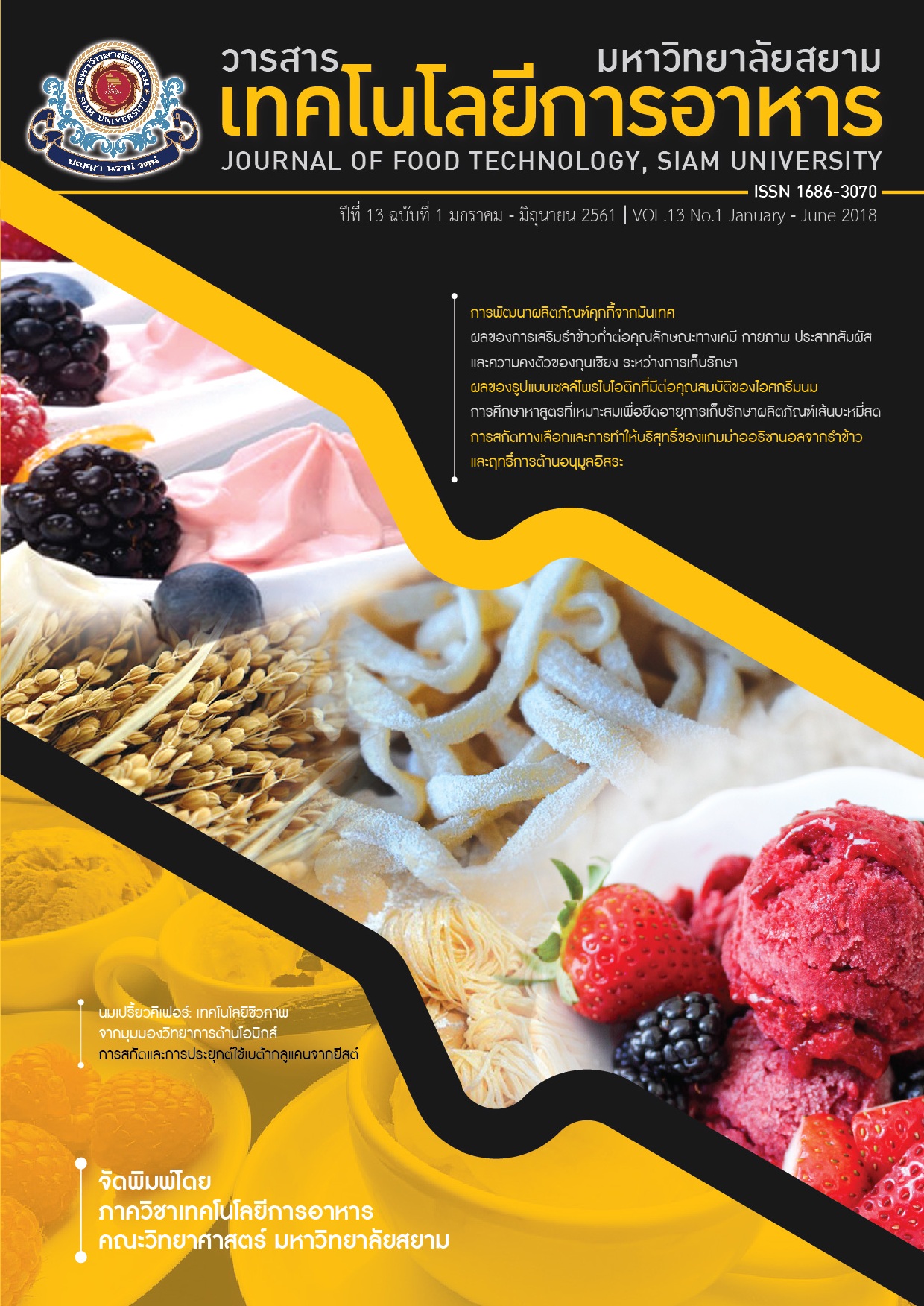Development of Cookie Products from Sweet Potato
Main Article Content
Abstract
Sweet potatoes contain many high nutrients, which are high carbohydrate and fiber. Moreover, they are delicious and inexpensive. The objectives of this research were to determine the effect of drying temperature on preparation of white, yellow, orange and purple sweet potato flours and to study the optimal ratio of sweet potato flour partially replaced by wheat flour in cookie products. Furthermore, the development of sweet potato cookie product was investigated. The optimization of sweet potato flour preparation with drying temperature of 50 ºC, 60 ºC and 70 ºC was studied. It was found that appropriated drying temperature for preparation of sweet potato flours was 60ºC for 28 hr. In terms of cookie product, the use of sweet potato flour partially replaced by wheat flour in cookie products was investigated by mixture design experiment for nine formulas. The results showed that the optimal formulation of cookie product contained of 40 g salted butter, 30 g sweet potato flour, 30 g wheat flour, 30 g icing sugar, 15 g eggs, 0.5 g baking powder and 0.2 g vanilla powder. It had the highest overall liking scores (7.77±0.82), which referred criteria as like moderately. In addition, the total antioxidant of sweet potato cookie was investigated by DPPH method. Results was found that total antioxidant of white, yellow, orange and purple sweet potato cookie had 45.20, 75.67, 93.16 and 133.59 mg eq Trolox/100 g, respectively. In conclusion, orange and purple sweet potato cookie had good quality and high nutritional value for consumer. It can be produced for selling on the health-conscious market in the future.
Article Details
Copyrights of all articles in the Journal of Food Technology available in print or online are owned by Siam University and protected by law.
References
[2] Guoquan, L. and Qainxin, G. (2011). Use of sweet potato in bread and flour fortification, pp. 407-416. In Preedy, V., Watson, R.R. and Patel, V.B. (eds.). Flour and breads and their fortification in health and disease prevention. Academic Press, UK.
[3] Phomkaivon, N., Surojanametakul, V., Poolperm, N. and Satmalee, P. (2016). Changes on physico-chemical properties, total anthocyanin contents and antioxidant activity of different pre-treatment purple sweet potato flour. [Online] Available from file:///C:/Users/ Administrator/Downloads/ KC5106029.pdf [Accessed July, 15, 2016].
[4] Sae-Khow, A., Tirawanichakul, S. and Tirawanichakul, Y. (2013). Effect of drying with heat convection and heat radiation on drying kinetics and quality aspect of black pepper. Burapha Science Journal. 18(1): 166-180.
[5] Duncan, D.B. (1995). Multiple range and multiple F tests. Biometrics. 11: 1–42.
[6] Association of Official Analytical Chemists (AOAC International). (2012). Official methods of analysis (19th edition), Washington, D.C.
[7] Yang, X., Yan, F., Huang, S. and Fu, C. (2014). Antioxidant activities of fractions from longan pericarps. Food Science Technology (Campinas). 34(2): 341-345.
[8] Association of Official Analytical Chemists (AOAC International). (2005). Official methods of analysis (18th edition), Washington, D.C.
[9] Community Product Standards 118/2555. (2012). Cookie. Thai industrial standards institute. [Online] Available from http:// app.tisi.go.th/otop/standard/standards.html. [Accessed July, 15, 2016].
[10] Rattanapanone, N. (2014). Food chemistry. Bangkok. Odian store. 504.
[11] Mordi, R.C. (1993). Mechanism of beta-carotene degradation. Biochemical Journal. 292: 310–312.
[12] Inchuen, S. (2012). Effect of hot-air drying temperature on colo, pasting and antioxidant properties. Khon Kaen Agriculture journal (supplement). 40(1): 478-485.
[13] Sukboonyasatit, D., Ruangsak, B., Srithong, W. and Cheungkuntod, S. (2017). Effect of sweet potato flour as wheat flour substitution on the characteristics of cookies. Khon Kaen Agriculture journal (supplement). 45(1): 1060-1065.
[14] Pornchaloempong, P. and Rattanapanone, N. (2016). Food network solution. [Online] Available from http://www. foodnetworksolution.com. [Accessed July, 15, 2016].
[15] Montilla, E.C., Hillebrand, S. and Winterhalter, P. (2010). Anthocyanin in Purple Sweet Potato (Ipomoea batatas L.) Varieties. Fruit, Vegetable and Cereal Science Biotechnology. 5: 19-24.
[16] Junpatiw, A., Mitmungkorn, Y. and Montri, N. (2017). Effects of heat and storage treatments on the anthocyanin contents in selected purple vegetables. Kaen Agriculture journal (supplement). 45: 1278-1282.
[17] Islam, S.N., Nusrat, T., Begum, P. and Ahsan, M. (2016). Carotenoids and b-carotene in orange fleshed sweet potato: A possible solution to vitamin A deficiency. Food Chemistry. 199: 628-631.
[18] Bovskova, H., Mikova, K. and Panovska, Z. (2014). Evaluation of egg yolk colour. Czech Journal of Food Sciences. 32(3): 213-217.
[19] He, X.L., Li, X.L., Lv, Y.P. and He, Q. (2015). Composition and color stability of anthocyanin-based extract from purple sweet potato. Food Science and Technology (Campinas). 35(3): 468-473.
[20] Ginting, E. (2013). Carotenoid extraction of orange-fleshed sweet potato and its application as natural food colorant. Jurnal Teknologi dan Industri Pangan. 24(1): 81-88.


